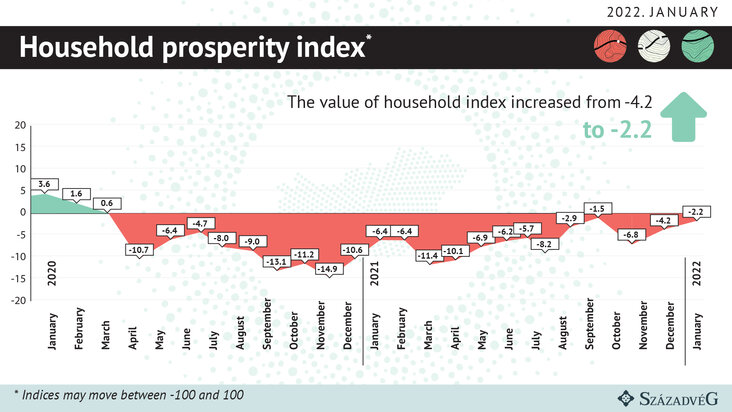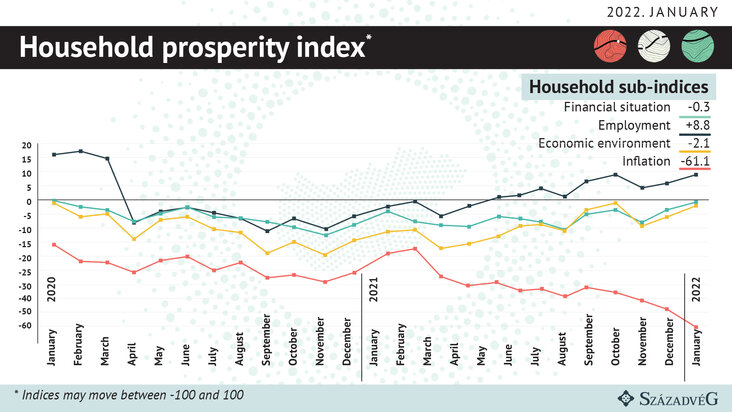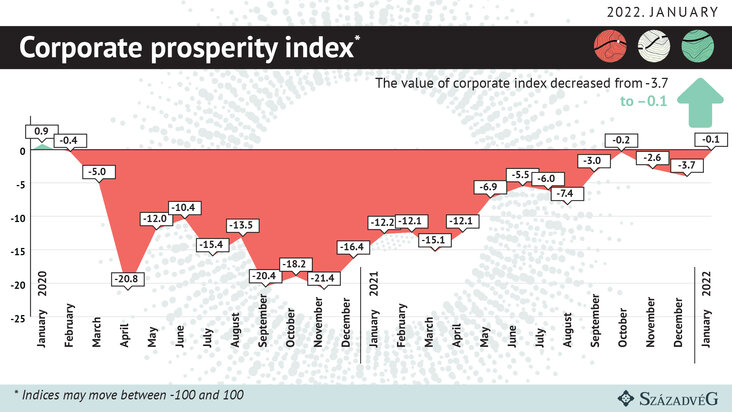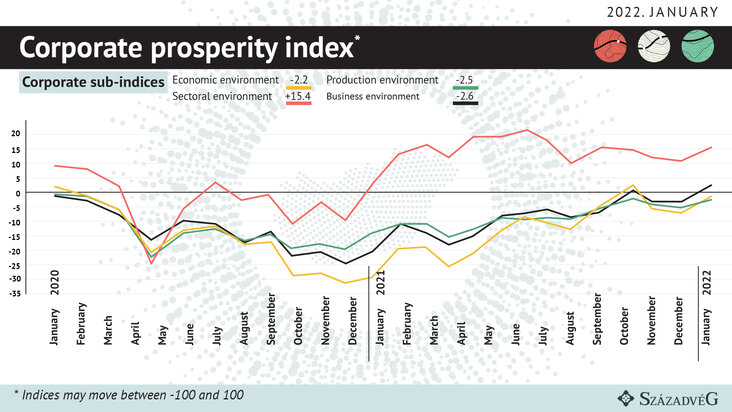According to the survey of Századvég Konjunktúrakutató in January 2022, the sense of prosperity of households and businesses improved: on a scale between -100 and +100, the value of prosperity index grew from -4.2 to -2.2 regarding households, while it grew from -3.7 to -0.1 regarding businesses. This has been the most favourable value for businesses since the appearance of the coronavirus in March 2020 and is not different from the pre-virus value. The sense of prosperity of households was more favourable only once, in October 2021, since the virus emerged. Further improvement in the sense of prosperity of households will require a significant curb on inflation and the improvement in related expectations. The development of energy prices, transport difficulties and shortages of raw materials in the next period may be decisive for companies, and regarding service sectors, the change in the coronavirus situation may be determinant. A favourable change in these may help to further improve the sense of prosperity.
The sense of prosperity of households and businesses have significantly improved


Three sub-indices of the household prosperity index have improved, and one has decreased compared to last month. The perception of employment by households is still the most favourable, +8.8 points, which is a noticeable improvement compared to the previous month’s +6.2. For the household survey, the biggest improvement is in the perception of economic environment on a monthly basis: the value of this index has grown from -5.9 to -2.1 points. The significantly increasing value of the improvement in the financial situation is not far behind, its value of -3.8 points in December changed to -0.3 in January. The most negative sub-index values can be attributed to the perception of inflation trends, in line with recent rise in inflation. The value of the index fell from the previous month’s -47.4 points to -61.1 points.

The results of the January survey show that the biggest improvement was in the issue of the expected development of the economic situation in the next 12 months. While 14.6 percent expected a significantly deteriorating economic situation in December, it was only 9.2 percent in January. The proportion of those who expect a slight deterioration in the situation hardly changed, it was 15.5 percent. Following the proportion of 18.8 percent in the previous month, now 20.0 percent expected an unchanged economic situation. The proportion of those expecting a slight improvement rose from 23.2 percent to 27.7 percent, while the proportion of those expecting a significant improvement rose from 12.7 percent to 13.6 percent.
The biggest negative change was in the inflation trends expected in the next 12 months. The proportion of those who expect an average inflation of less than 1 percent remains low (1.4 percent), but the proportion of those who expect inflation to fall by 1 to 2 percent has also declined (from 8.0 percent to 5.7 percent). Only 12.5 percent of those surveyed expect inflation to remain within the central bank’s target range over the next 12 months, the rate of which was 20.0 percent in December. Following the proportion of 19.9 percent in December, 20.9 percent expect inflation of 4-5 percent, while higher inflation is considered possible by 47.7 percent instead of 40.7 percent.

In the corporate survey, the value of all four sub-indices showed more favourable values from December to January. The biggest positive change took place in the perception of the business environment, the value of the sub-index changed significantly, from -2.6 to +2.6. The perception of the sectoral environment is still the most favourable, but there was also a substantial improvement here, from +10.6 to +15.4. The index of the economic environment rose from -7.2 to -2.2, while that of the production environment rose from -5.3 to -2.5.

Regarding the corporate survey, no question showed a significant deterioration in January, so we present two questions for which the figures turned out to be outstandingly positive. The results of the corporate survey show a high degree of similarity to the results of the household survey. In this case, too, the perception of the economic processes expected for the next 12 months substantially improved. While in December, 12.0 percent of companies expected a significant deterioration, it was only 8.6 percent in January. Following the previous month’s 22.6 percent, the proportion of those expecting a slight deterioration was only 18.5 percent. The share of those forecasting an unchanged economic situation hardly changed, it was 24.5 percent in January. Following the previous month’s 28.8 percent, the proportion of those expecting a slightly improving economic situation was 30.8 percent, and that of those expecting a significantly improving economic situation was 6.7 percent following the previous month’s 5.4 percent.
Production expectations for the next 12 months also improved. While the proportion of those expecting a significant decrease in production was 3.0 percent and that of those expecting a slight decrease was 12.0 percent in December, these two ratios fell to 1.7 percent and 8.7 percent, respectively, in January. The proportion of those expecting unchanged production fell from 40.8 percent to 39.3 percent, and that of those forecasting a slight increase rose from 36.2 percent to 39.1 percent, and that of those forecasting significant growth rose from 4.0 percent to 6.5 percent.
About the prosperity index
The task of the prosperity research conducted by the Századvég Konjunktúrakutató Zrt. is to provide decision makers and analysts with information about the current and expected processes of the economy in the near future. Our institute has been compiling corporate and household prosperity indices on a monthly basis since August 2019. In our monthly survey, we ask 1,000 company executives and 1,000 adult residents about their assessment of the economic situation and their expectations thereof. Regarding the two groups, we ask 29 and 28 questions, respectively, which cover a wide range of economic life. Of the responses, positive ones (e.g., expected improvement in the economic situation) receive positive scores, while negative ones (expected decline in employment) receive negative scores. Then, by averaging the scores and converting them to a scale between -100 and +100, the prosperity indices are obtained. Thus, the higher the value of the prosperity indices, the more favourable the processes in the economy are for households and companies. In addition, regarding both household and corporate surveys, we also prepare 4 sub-indices for each by using some of the questions, which illustrate the development of economic well-being in an area.
